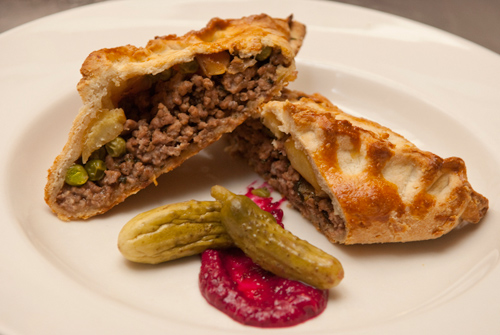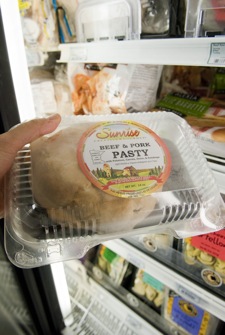
It is a marvelous thing to counter the brittle, barren cold of a Midwestern winter with its natural enemy: a piping hot filling of meat and vegetables encased in a dense, but flaky crust. I’m not talking about our old friend the Hot Pocket, though that microwaveable waking nightmare owes much more than a tip of the hat to our subject. I am referring here to the Cornish pasty, an old immigrant dish that has nourished generations of northern Michiganers and Minnesotans since its arrival from Cornwall, England.

An influx of Cornish immigrants into the mining towns of the Upper Midwest in the mid-1800s literally changed the shape of the working class man’s packed lunch — specifically, into the iconic half-moon of the pasty. As far as anyone can remember, the shell has typically been filled with diced potatoes, rutabagas, onions, and beef and served dry, with the filling’s juices acting as the sauce. The flour-to-fat ratio in the pasty dough is close to a pie’s, but must be made tougher in order to withstand transport by a husky miner.
The tradition lives on in the pasty shops which pepper the region, from Joe’s Pasty Shop in Butte, MT. to Myles Teddywedger’s in Madison, WI. However, there are enough regional variations here to decisively separate them from their forebears in Cornwall. Joe’s, for example, serves their house pasty covered in chili, cheddar, and diced raw onions. And many purveyors, such as Lawry’s in Ishpeming and Marquette, MI, offer at least one vegetarian take on the dish.
For the purposes of this story, we purchased a pasty (now $3.47 at local co-ops) from Sunrise Gourmet in Hibbing, MN, as our recipe launching point. Their filling consists of beef, pork, rutabaga, carrot, potato, and onion, seasoned very conservatively with the briefest touch of salt and pepper. In a pinch, it would be a decent lunch, but only if one has an oven available. Microwaving this would just turn it into a volcanic pile of soggy horror.

Our venture into pasty-making really taught us a thing or two. First, that it wasn’t as backbreakingly laborious as we’d assumed it would be. Second, that an animal-based fat is really the best option for the dough. And lastly, that eating one-and-a-half pasties in the course of an hour is an absolutely terrible idea. We immediately kicked out any pretension of making anything “authentic,” and went ahead with things that seemed appealing: local ground lamb; a Welsh cheddar studded with mustard seeds; peas; and lots of duck fat.

Pasties
Serves six
The Shell
5 c all-purpose flour
2 tsp salt
1 c fat (We used duck fat with great results.)
⅓-½ c milk
The Filling
1 ½ lb ground lamb
2 tbsp mint, julienned
2 tennis ball-sized rutabagas, peeled and diced
3 potatoes, peeled and diced (We used Yukon Golds, but any waxy types would work here.)
2 onions, diced
1 c green peas
Optional: A really punchy-flavored cheese
3 eggs, beaten for egg wash
- Preheat oven to 400˚F.
- Combine the dry dough ingredients in a large bowl. Break up the fat in between your fingers and toss the pieces in the bowl to coat them thoroughly with flour. Incorporate fat until the mixture becomes grainy. Add just enough milk to make dough into a cohesive mass. Knead lightly. Cover and refrigerate until needed. (You may certainly skip this step and purchase premade pie dough.)
- Season the raw lamb with salt and pepper to taste. Briefly brown in a skillet, then drain the fat. Set aside. Add the mint leaves.
- Brown the vegetables in a skillet with oil or butter and season to taste. Deglaze the pan with white wine to create a little bit of sauce. Set aside.
- Roll out the pasty dough to about ⅛”. Use a medium-sized saucer to cut out rounds with a knife. You should be able to combine dough scraps to make the sixth “Frankenpasty.”
- Wet the outer rim of a dough circle with the egg wash. Drop meat and vegetables onto the center.
- Pull up the sides of the dough circle to meet on top of the filling. Pinch the edges together to form a crimped seal. Using a knife, cut slits into the top of the pasty to allow steam to escape during baking.
- Brush the egg wash over the pasty.
- Repeat until finished with dough and filling.
- Bake for 30-45 minutes or until vegetables are tender.
- Serve with ketchup, mustard, gravy, chili, cornichons…


Whenever I am in Grand Rapids, MN I stop at Pasty’s Plus for a dozen or so pasty’s. They sell them frozen. Hmmm…..I think I need to visit my uncle soon…
I’ve had best results in pasty making when I don’t cook the meat (or anything else) before filling the pasty. (Maybe you lightly browned the lamb because it was too fatty.) I use ground venison or lean grass-fed beef. I cut the carrots and rutabagas into julienne, then crosswise into tiny dice; the potatoes are normal-sized dice. This way, nothing needs to be pre-cooked before it gets wrapped, and all the natural juices make the filling moist (so there’s no need to manufacture a sauce to keep the interior from being dry). I learned my technique from my friend Ron Berg, former chef at Gunflint Lodge; he, in turn, learned it from a Yooper he knows (that’s Michigan’s Upper Peninsula, for those not familiar with the term… UPer = Yooper).
You recipe has me inspired to get a ‘baga at the co op today and make a batch of pasties! Thanks for writing this.
Teresa M,
Thanks for explaining the Yooper thing. I was really puzzled for a moment there. But you’re correct; I browned the lamb because I didn’t want the pasties to get super greasy. It’s definitely skippable if you use lean meat.
I’ve made totally inauthentic yet tasty pasties with leftover post roast & the veg I cooked it with (root veggies and mushrooms) wrapped in crescent roll dough- one can of rolls is enough dough for about 3. I think this may be my most stereotypically Midwestern culinary concoction.
For a generous but yummy diner lunch, Milda’s Cafe on Penn Ave N can’t be beat for a pasty. Mmmmmm. Giant.
Since my family was German, we had Fleischkuechle instead. German food = bland, so pastry pockets only had hamburger inside them, no veg. And a nice mustard for dipping. (And we dropped them in a FryDaddy as opposed to baking them).
I’ve also tried substitutes for not making the dough; crescent rolls, premade pie dough, pizza pie dough(close, but puffy)…they never come close to a dough that’s really not that hard to make, so we shouldn’t be skipping over it.
As far as animal fat, up to you, but this one comes close in my mind to all the ones I’ve had in those little town shops in Wisc., on your drive to Bayfield.
3 c. flour
1 1/2 sticks butter (cold and cut into bits)
1 1/2 tsp. salt
6 tbsp. water
(add a little seasoning if you like)
Work it together, if you have time, let it chill a little, alot easier to work with than premade stuff.
The filling, go with the traditional stuff, or as I often do, use it to get rid of leftovers.